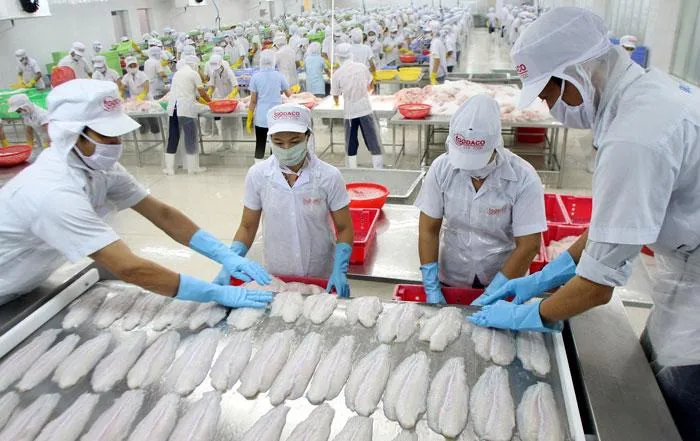US tariffs disrupt Vietnamese exports, urgent policy response needed
Vietnam is mobilizing tax reforms, digital tools, and policy relief to help exporters cope with steep US tariffs affecting key sectors like textiles, wood, and seafood.
In response to the US decision to impose a 46% tariff on Vietnamese exports, government agencies and experts are taking urgent steps to mitigate the impact and maintain economic momentum.
Speaking at the "Responding to US Reciprocal Duties" seminar in Hanoi on April 8, Mai Son, Deputy Director General of the Authority for Taxation under the Ministry of Finance, outlined immediate measures, including stricter supervision of tax refunds for enterprises engaged in simple processing and re-export.

Government leaders and experts attend the "Responding to US Reciprocal Duties" seminar on April 8. Photo: Tien Phong Newspaper
"We need to increase tax transparency, especially for companies with low value-added production," he said.
He also called for greater use of digital technology in tax administration, improved databases for international trade transactions, and further information sharing with US tax authorities to improve transparency and prevent cross-border tax fraud.
"To ease liquidity constraints, especially for export-import businesses, Vietnam is speeding up the processing of VAT refunds for businesses that fulfill orders from foreign traders with legal presence in the country. The move is expected to ease working capital constraints and stimulate reinvestment," the deputy director said.
Son said the government has also introduced several policy tools to ease the tax burden and create economic leverage. These include tariff reductions on imports of key goods from the US, tax payment deferrals for domestically assembled vehicles, and delayed obligations for VAT, corporate income tax, personal income tax, and land rent in 2025.
Major export sectors such as textiles, timber, and seafood have been disrupted, with many companies halting shipments to the US amid shrinking margins and rising inventories. These industries, which account for 64.3% of the country's total exports to the US in 2024, now face contract renegotiations, financial penalties, and heightened uncertainty under the new tax regime.
Textile exports face sharp decline

Workers at the Nha Be Garment factory. Photo: Nha Be Garment JSC
Textiles, Vietnam's leading export to the US with earnings of more than $16 billion in 2024, are already feeling the heat. "Trump's reciprocal tariff policy came unexpectedly and far exceeded our forecasts," Hoang Manh Cam, Deputy Chief of Office of the Board of Directors of the Vietnam National Textile and Garment Group (Vinatex), said at the seminar.
He warned that higher costs would reduce demand in the short term and predicted a drop in orders from the second quarter of 2025.
Despite the gloomy outlook, Vinatex believes the global supply chain may not shift dramatically this time around because "the US is imposing tariffs on all countries, not just Vietnam." Competitors in Africa and Latin America also face challenges such as lower production capacity and political instability, making them less viable alternatives to Vietnam.
"Take clothing as an example. If prices go up by 1%, demand goes down by 1%-2%. If a pair of pants that used to sell for $50 now costs $55 due to a 5% tariff increase, demand could fall by as much as 20%," he explained.
Wood industry in shock
Vietnam's timber industry, with $9.4 billion in exports to the US accounting for 38% to 40% of total production in 2024, has been particularly hard hit. "In the past five days, our industry has been in complete shock," said Ngo Sy Hoai, Vice Chairman of the Vietnam Timber & Forest Products Association (Viforest), citing the newly announced 46% tariff on Vietnamese timber exports.
“The US needs us as much as we need them,” he said. “Roughly 4,000 small and medium-sized firms and around one million farming households across the supply chain will be affected.”
While businesses acknowledge the risks of overreliance on one market, finding replacement markets won’t be easy. Hoai suggested the crisis could be a turning point. “This might be the moment for us to rethink our path and find a new direction for Vietnam’s wood industry,” he said.
Seafood exporters on edge

Processing frozen catfish for export at Go Dang Company, My Tho Industrial Park, Tien Giang Province. Photo: Hung Viet/Kinh te & Do thi Newspaper
Vietnamese seafood companies have responded with alarm. “Right after Trump announced the 46% tariff on Vietnamese exports, seafood businesses were thrown into panic,” Le Hang, Deputy Secretary General of the Vietnam Association of Seafood Exporters and Producers (VASEP), said at the event.
At the time of the announcement, nearly 40,000 tons of seafood were already en route to the US, raising immediate concerns about whether these shipments would be taxed retroactively.
"Vietnamese seafood doesn't just face the 46% reciprocal tariff as there are additional tariffs, including countervailing and anti-dumping duties, which can bring the total tax up to 75%."
She added that most Vietnamese exporters use cost, insurance, and freight (CIF) shipping terms, which means they are responsible for transportation, insurance, and tax costs. As a result, the financial pressure will fall directly on local companies.
Many exporters have paused contract signings and halted shipments, risking penalties for breaching agreements. The industry fears losing the US market altogether, which accounts for up to $1.8 billion in seafood exports in 2024, particularly shrimp and pangasius, she said.
Economist Nguyen Quang Huy urged businesses to seize this moment to upgrade supply chains, shift from low-value processing to higher-value production, strengthen legal resilience in trade defense, and diversify markets.
“This is a wake-up call,” he said. “Enterprises with strong capital and adaptability will thrive in the new global trade order.”








